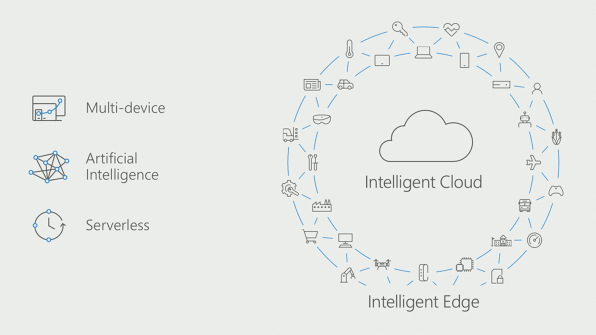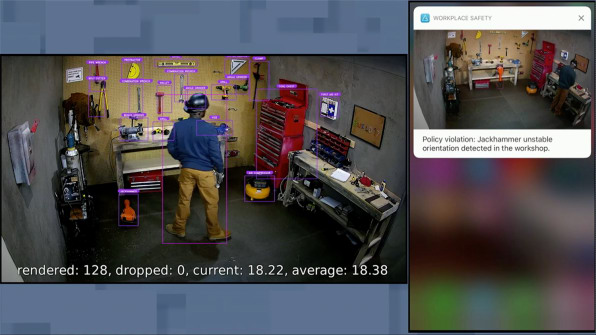At Build, Microsoft’s Vision Of The Future Workplace Looks Both Helpful And Intrusive
At its Build developer conference in Seattle, Microsoft brought to life a vision of the workplace of the future where workers are surrounded by all manner of cameras, sensors, and other recording devices connected to internet-based AI services.

Put another way, Microsoft sees the intelligent edge as a technology layer that could show up anywhere in the physical world. Whatever role Microsoft plays, it’s a mildly disturbing look at workplace of the future.
That feeling you have when you’re parked at a traffic light and you know the cameras are on you? That could be our 24/7 reality at work, as analyst Ross Rubin put it to me here in Seattle at Microsoft’s Build developer conference.
Microsoft showed demos and videos of the “intelligent edge” in a variety of forms, in a variety of use cases, and in a variety of industries:
- A heart patient was walking around wearing a sensor. He began to get tired, so the sensor sent that data up to the cloud for processing, and a nurse was notified to bring him a wheelchair.
- A camera detected an employee accidentally tipping over a barrel containing a dangerous chemical, information it sent up to image-recognition software in the cloud. Some other database likely helped determine that the liquid in the barrel was hazardous. Presumably an alarm was sent to a cleanup team.
- An employee in a shop was spotted taking a selfie while brandishing a jackhammer. The brain in the cloud recognized the employee, the activity, and the setting and concluded he was behaving recklessly, then contacted a supervisor.
- Someone else in a shop was seen not wearing safety goggles. Alarm. Supervisor notified.

All this involves some sophisticated, on-the-fly AI. In the words of the presenter demoing the intelligent edge developer tools at Build: “The solution is running more than 27 million recognitions per second across people, objects, and activities.” But the use cases Microsoft showed onstage sound equal parts helpful and intrusive. Sure, getting a heart patient back to bed or detecting a dangerous chemical spill are health-promoting. But the notifications to the supervisor suggest a completely different, and possibly unintended, consequence of the technology.
There is benevolent surveillance and then there is just surveillance, and the Microsoft technology could work in both scenarios.

Of course Microsoft didn’t invent the internet of things, the umbrella term reflecting the addition of connectivity and intelligence to devices from washing machines to factory presses to front doors in the physical world. A world increasingly watched by cameras and sensors is happening whether Microsoft plays a role in it or not.
But Microsoft embraced this paradigm enthusiastically here at Build, and carefully defined its place in it—in the same way it did with the chat bots that were a key theme at last year’s conference.
The company is acutely aware of the implications of imbuing the cameras and sensors and other stuff around us with intelligence. CEO Satya Nadella–a very smart and thoughtful guy–wasn’t four minutes into his opening remarks here before he began to talk about how technology could be used for bad, not good. He told developers it’s up to them to make sure the “intelligent edge” doesn’t become the “surveillance edge.”

He even referenced dystopian futures of George Orwell’s 1984, with its constant surveillance, and Aldous Huxley’s Brave New World with tech helping distract people from any kind of “meaning or purpose” in life.
“We should empower people with technology,” Nadella told developers in a tone that, on second listen, sounded almost sermon-esque. “People have to be in the loop.”
“It’s up to us as the world becomes more tech driven, as digital technology becomes a bigger part of everyday life, building trust in technology is crucial,” he added. “It starts with us taking responsibility for ensuring that there is more trust in technology each day.”
The scenarios Microsoft showed off were more about what third-party developers can do using the company’s services than offerings it plans to sell itself, and it’s not even clear how close they might be to being generally available. But Microsoft is staking its claim to the job of imbuing all those little edge devices with human-like intelligence and judgement.
How much control will Microsoft really have over the ways in which developers use those assets in the wild? Will all those little cameras and sensors on the edge act like helpful guardian angels? Or brainy little tattletales? Nadella raised some of those questions himself during his keynote, but the answers are yet to come.
Fast Company , Read Full Story
(37)



